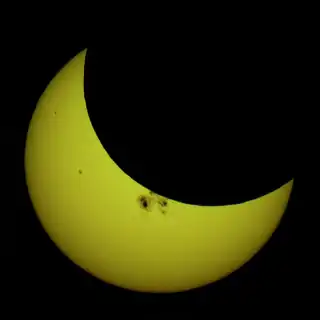| Solar eclipse of September 30, 1913 | |
|---|---|
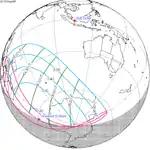 Map | |
| Type of eclipse | |
| Nature | Partial |
| Gamma | −1.1005 |
| Magnitude | 0.8252 |
| Maximum eclipse | |
| Coordinates | 61°00′S 11°36′E / 61°S 11.6°E |
| Times (UTC) | |
| Greatest eclipse | 4:45:49 |
| References | |
| Saros | 152 (7 of 70) |
| Catalog # (SE5000) | 9311 |
A partial solar eclipse occurred on September 30, 1913.[1][2][3][4] A solar eclipse occurs when the Moon passes between Earth and the Sun, thereby totally or partly obscuring the image of the Sun for a viewer on Earth. A partial solar eclipse occurs in the polar regions of the Earth when the center of the Moon's shadow misses the Earth.
Related eclipses
Solar eclipses 1910–1913
This eclipse is a member of a semester series. An eclipse in a semester series of solar eclipses repeats approximately every 177 days and 4 hours (a semester) at alternating nodes of the Moon's orbit.[5]
| Solar eclipse series sets from 1910–1913 | ||||
|---|---|---|---|---|
| Ascending node | Descending node | |||
| 117 | May 9, 1910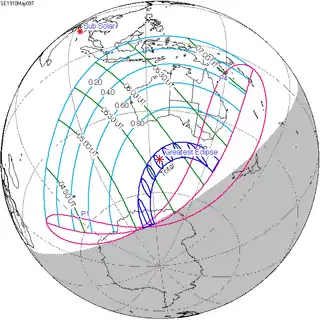 Total |
122 | November 2, 1910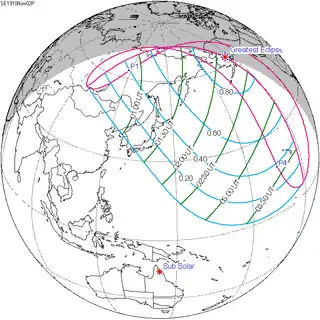 Partial | |
| 127 | April 28, 1911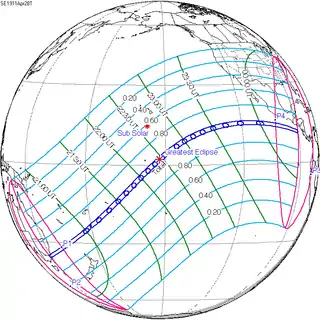 Total |
132 | October 22, 1911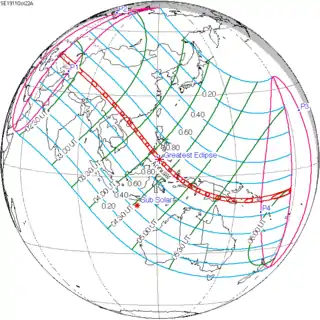 Annular | |
| 137 | April 17, 1912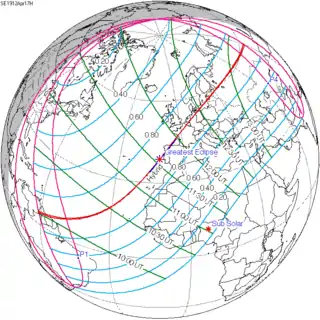 Hybrid |
142 | October 10, 1912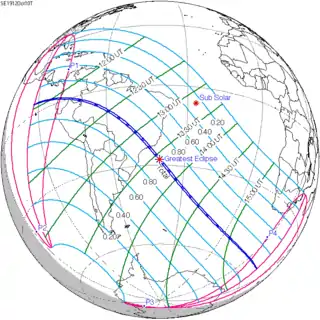 Total | |
| 147 | April 6, 1913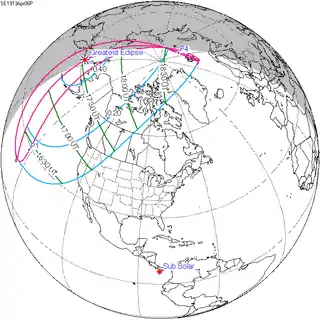 Partial |
152 | September 30, 1913 Partial | |
References
- ↑ "The heavens in September". The Commercial Appeal. Memphis, Tennessee. 1913-08-31. p. 51. Retrieved 2023-11-04 – via Newspapers.com.
- ↑ "THE HEAVENS IN SEPTEMBER". The Times-Democrat. New Orleans, Louisiana. 1913-08-31. p. 29. Retrieved 2023-11-04 – via Newspapers.com.
- ↑ "An enterprising hawker". Cambridge Evening News. Cambridge, Cambridgeshire, England. 1913-09-30. p. 3. Retrieved 2023-11-04 – via Newspapers.com.
- ↑ "ECLIPSE OF THE SUN". Western Mail. Cardiff, South Glamorgan, Wales. 1913-09-30. p. 8. Retrieved 2023-11-04 – via Newspapers.com.
- ↑ van Gent, R.H. "Solar- and Lunar-Eclipse Predictions from Antiquity to the Present". A Catalogue of Eclipse Cycles. Utrecht University. Retrieved 6 October 2018.
External links
- Earth visibility chart and eclipse statistics Eclipse Predictions by Fred Espenak, NASA/GSFC
This article is issued from Wikipedia. The text is licensed under Creative Commons - Attribution - Sharealike. Additional terms may apply for the media files.
.jpg.webp)

